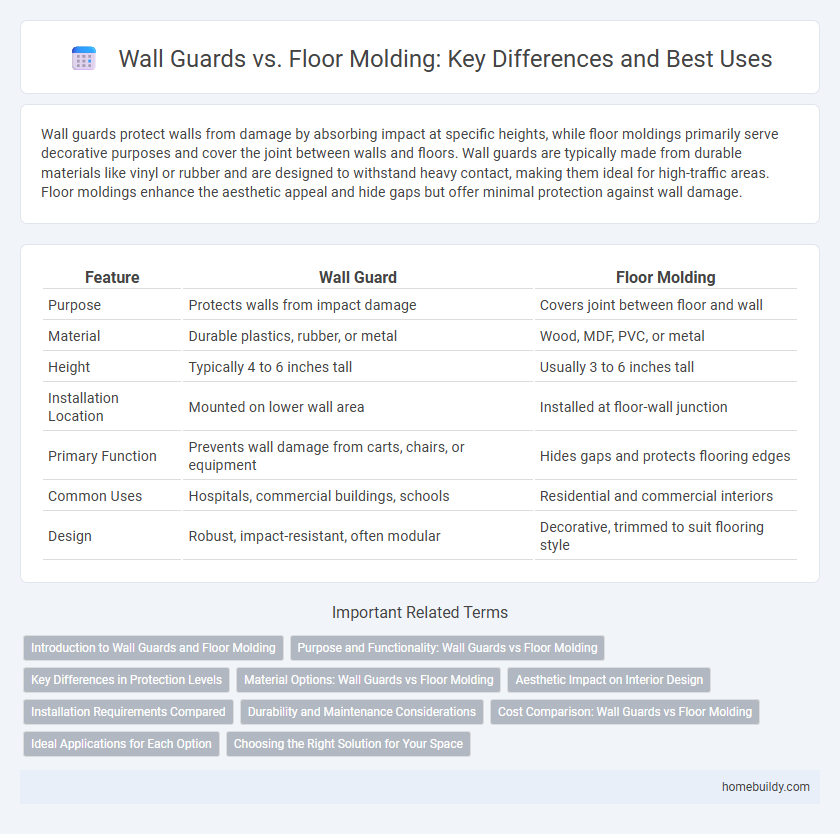Wall guards protect walls from damage by absorbing impact at specific heights, while floor moldings primarily serve decorative purposes and cover the joint between walls and floors. Wall guards are typically made from durable materials like vinyl or rubber and are designed to withstand heavy contact, making them ideal for high-traffic areas. Floor moldings enhance the aesthetic appeal and hide gaps but offer minimal protection against wall damage.
Table of Comparison
| Feature | Wall Guard | Floor Molding |
|---|---|---|
| Purpose | Protects walls from impact damage | Covers joint between floor and wall |
| Material | Durable plastics, rubber, or metal | Wood, MDF, PVC, or metal |
| Height | Typically 4 to 6 inches tall | Usually 3 to 6 inches tall |
| Installation Location | Mounted on lower wall area | Installed at floor-wall junction |
| Primary Function | Prevents wall damage from carts, chairs, or equipment | Hides gaps and protects flooring edges |
| Common Uses | Hospitals, commercial buildings, schools | Residential and commercial interiors |
| Design | Robust, impact-resistant, often modular | Decorative, trimmed to suit flooring style |
Introduction to Wall Guards and Floor Molding
Wall guards and floor moldings serve distinct purposes in interior protection and aesthetics; wall guards shield walls from damage in high-traffic areas while floor moldings cover the joint between flooring and walls, providing a finished look. Wall guards are typically made from durable materials like PVC or rubber, designed to absorb impacts, whereas floor moldings, such as baseboards or shoe moldings, are often crafted from wood, MDF, or vinyl for decorative and sealing functions. Understanding the differences helps in selecting the right solution for maintaining wall integrity and enhancing room appearance.
Purpose and Functionality: Wall Guards vs Floor Molding
Wall guards protect walls from damage caused by carts, equipment, and foot traffic, making them essential in high-traffic areas such as hospitals and commercial buildings. Floor molding primarily serves as a decorative transition between walls and floors, concealing expansion gaps and providing a clean finish. While wall guards focus on durability and impact resistance, floor molding emphasizes aesthetic appeal and protection of flooring edges.
Key Differences in Protection Levels
Wall guards offer superior protection by absorbing and deflecting impacts at higher wall levels, preventing damage from carts, equipment, and foot traffic, whereas floor moldings mainly protect lower wall edges from scuffs and abrasions. Wall guards are typically constructed from robust materials like high-impact vinyl or rubber, providing enhanced durability and resistance to repeated impacts compared to floor moldings, which prioritize aesthetic edge protection. The key difference lies in their design purpose: wall guards safeguard vertical surfaces against substantial impact damage, while floor moldings primarily prevent wear and tear along the wall-floor junction.
Material Options: Wall Guards vs Floor Molding
Wall guards are commonly made from durable materials such as vinyl, rubber, and stainless steel to withstand impact and protect walls in high-traffic areas. Floor moldings typically use wood, MDF, or flexible PVC, focusing more on aesthetic finishes to complement flooring and baseboards. Choosing between wall guards and floor moldings depends on whether protection or decorative trim is the primary requirement.
Aesthetic Impact on Interior Design
Wall guards provide a sleek and continuous protective barrier along walls, enhancing the room's aesthetic by maintaining a clean, uninterrupted visual line. Floor moldings, while decorative, often introduce breaks in design flow due to their bulkier presence and focus on covering joint gaps. Choosing wall guards over floor molding refines interior design by emphasizing modern minimalism and seamless wall-to-floor transitions.
Installation Requirements Compared
Wall guards typically require mounting directly onto walls using anchors or screws for secure attachment, often demanding wall surface preparation to ensure stability. Floor molding installation involves securing the molding at the base of walls, usually nailed or glued to the floor, with careful measurement to fit edge transitions cleanly. Installing wall guards generally demands more precise alignment and hardware placement to resist impact, whereas floor molding prioritizes seamless floor-wall junction coverage and protection from foot traffic abrasion.
Durability and Maintenance Considerations
Wall guards offer superior durability compared to floor moldings, often made from robust materials like vinyl or rubber that resist impact and abrasion in high-traffic areas. Maintenance for wall guards is minimal, requiring only occasional cleaning, whereas floor moldings can be prone to scuffs and damage from foot traffic and cleaning equipment, leading to more frequent repairs or replacement. Choosing wall guards enhances long-term protection for walls with lower upkeep costs, making them ideal for commercial or industrial environments.
Cost Comparison: Wall Guards vs Floor Molding
Wall guards typically cost between $2 to $15 per linear foot, depending on the material and design, while floor moldings generally range from $1 to $10 per linear foot. Installation of wall guards may require professional labor, increasing overall expenses, whereas floor molding installations can often be completed as a DIY project, reducing labor costs. Considering durability and maintenance, wall guards often provide better long-term value despite the higher upfront cost compared to floor moldings.
Ideal Applications for Each Option
Wall guards are ideal for protecting walls in high-traffic areas such as hospitals, schools, and commercial buildings where impact resistance is crucial. Floor molding is better suited for residential settings or offices where aesthetic finish and floor protection from dust and minor impacts are priorities. Choosing between wall guards and floor molding depends largely on the level of durability required and the specific environmental conditions of the space.
Choosing the Right Solution for Your Space
Wall guards provide superior protection against impacts and scuffs for high-traffic areas, preserving wall integrity more effectively than floor molding. Floor molding primarily enhances aesthetic appeal and covers gaps at the base of walls, but does not offer substantial damage resistance. Selecting wall guards over floor molding ensures durable, functional defense in environments prone to heavy wear and tear.
Wall guard vs Floor molding Infographic

 homebuildy.com
homebuildy.com